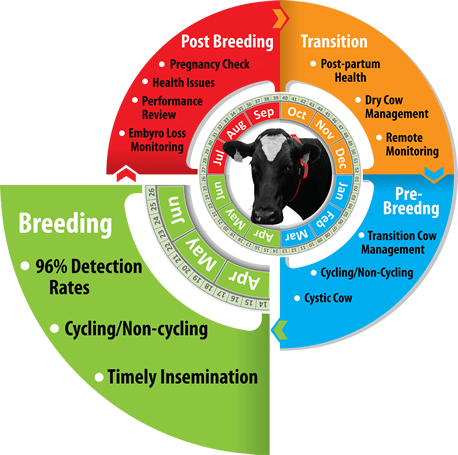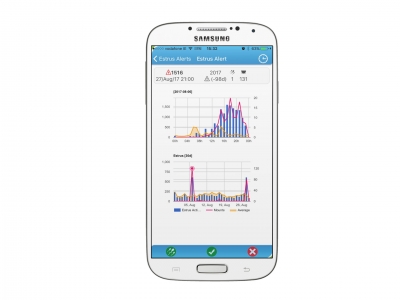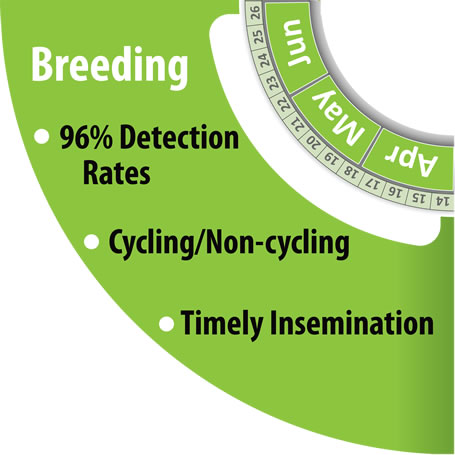BREEDING PERIOD
During the herd breeding period the focus is very much on getting healthy cows pregnant quicker, improving the 6 week in calf rate to enable more days in milk in early lactation, fewer replacements, fewer empties and improved herd and milk quality through selection.

“The increase in submission rate has improved my six week in calf rate by 20%” – Liam Houlihan, Limerick, Ireland. 100 collars
Key Focus Areas During This Period Include:
 Detection Rates
Detection Rates
The single most important problem limiting high reproductive efficiency in dairy herds is poor estrus detection. A typical estrus detection rate of 50% highlights the challenge of estrus detection. Failure to detect estrus results in an estimated annual loss of over $300 million to the dairy industry in the US.
It is essential to understand the primary and secondary signs of heat in order to achieve accurate and efficient heat detection. Getting it right is a challenge that involves a significant amount of labour expense, effort and guesswork. Yet getting cows in calf quickly is at the core of every farmers business.
How Can HerdInsights Help?
- HerdInsights, by using a multimetric analysis on each individual cows’ behaviours can accurately and efficiently detect cows in heat, taking the guess work out of it for the farmer with less time and hassle
- With a validated 96% heat detection rate, HerdInsights is very efficient in detecting silent heats
- By detecting the onset of estrus conception rates are increasing by up to 20% on our existing customers farms
- In addition to significantly improving your herds reproductive performance, HerdInsights will enable you to reduce straw usage and time spent observing cows. Current recommendations are that for the period of AI use which is approximately 6 weeks traditional heat detection observation should take place for 3 periods of 30 mins each day
For Further Information On Detection Rates Click On Headings Below
The single most important problem limiting high reproductive efficiency in dairy herds is poor estrus detection. A typical estrus detection rate of 50% highlights the challenge of estrus detection. Failure to detect estrus results in an estimated annual loss of over $300 million to the dairy industry in the US.
It is essential to understand the primary and secondary signs of heat in order to achieve accurate and efficient heat detection. Getting it right is a challenge that involves a significant amount of labour expense, effort and guesswork. Yet getting cows in calf quickly is at the core of every farmers business.
Accurate heat detection is affected by many factors such as:
- Type of housing
- Footing surface
- Lameness
- Stocking density
- Temperature
- Higher 6 week in calf rate
- More days in milk
- Tighter calving pattern
- Earlier identification of reproductive health issues pre-breeding
- Reduction in empty rates
- Improved conception rates

Dairy Cows Cycling/Non-Cycling
Dairy cows that have had a normal calving event and are healthy and well managed return to normal cyclicity within 15-20 days of calving. The first heat should be observed from approximately day 25 after calving and then normally occurs at 18-24 day intervals thereafter.
On average 50-80% of cows within a herd fall into this category, with the balance of cows having delayed resumption of ovulation. A proportion of cows, given time, will repair any minor damage to the reproductive system after calving. Some, however, do need intervention to ensure that they resume cycling in time for the breeding season.
Early identification of non-cycling cows enables earlier intervention pre-breeding maximising submission and pregnancy rates. Failure or late identification of these “problem” cows will result in an extended calving season, a shortened lactation number and increase the likelihood of eventually culling the cow.
How Can HerdInsights Help?
- HerdInsights automatically generates a list of cows pre-breeding that are not cycling relative to their calving date
- HerdInsights highlights the calving to first heat period
For Further Information On Cycling/Non-Cycling Click On Headings Below
Dairy cows that have had a normal calving event and are healthy and well managed return to normal cyclicity within 15-20 days of calving. The first heat should be observed from approximately day 25 after calving and then normally occurs at 18-24 day intervals thereafter.
On average 50-80% of cows within a herd fall into this category, with the balance of cows having delayed resumption of ovulation. A proportion of cows, given time, will repair any minor damage to the reproductive system after calving. Some, however, do need intervention to ensure that they resume cycling in time for the breeding season.
Early identification of non-cycling cows enables earlier intervention pre-breeding maximising submission and pregnancy rates. Failure or late identification of these “problem” cows will result in an extended calving season, a shortened lactation number and increase the likelihood of eventually culling the cow.
The most common reasons for delayed resumption of cyclicity are excessive loss of body condition, and/or severe metabolic/disease insults in the early postpartum period.
HerdInsights automatically generates a list of cows pre-breeding that are not cycling relative to their calving date.
This list can be easy accessed on your mobile phone and can be forwarded to your vet or scanner for attention. All cows that are not seen in heat by day 42 should be examined by the vet. It is these problem cows that your vet should be putting the effort into in order to get them into oestrus as soon as possible cows that will give a return on investment of vet fees.
Additionally, HerdInsights highlights the calving to first heat period. This duration will help management in assessing nutrition, BCS, genetics and management practices and can be used as a decision aid when evaluating transition cow management practices.
Not identifying your non-cycling cows results in a calving to pregnancy interval approaching 400 days.
Replacement rates of 20-30% are required to maintain a 14-week calving period for grass-based milk production systems.
A cow calving in May will generate €400 less profit than a cow calving in February, due to higher feed costs and reduced yield (Teagasc). As such increasing submission rates on cows that are eligible to be bred will maximise profits.
 Timely Insemination
Timely Insemination
Since cattle should be inseminated so that viable sperm are at the fertilization site as the unfertilized egg arrives, it is important to estimate the time of ovulation for each cow that is to be inseminated.
Sperm have to be in the female reproductive tract for approximately six hours before they are capable of fertilising the egg. Although live sperm have been found in the female tract up to 48 hours after insemination, sperm viability usually is estimated to be 18 to 24 hours. Improper semen handling or poor insemination technique can dramatically reduce the number of sperm cells available for fertilisation and thus can lower the conception rate.
How Can HerdInsights Help?
- When a cow is in heat HerdInsights will send an alerts directly to the farmers and/or inseminators phone. Included in the alert will be critical information that will increase the likelihood of a conception
- HerdInsights will indicate when the onset of estrus commenced maximising your chances of success
- Other information such as DIM, previous estrus duration, time between estrus events and whether or not previously served will be displayed in the alert and will greatly improve pregnancy rates on farm
For Further Information On Timely Insemination Click On Headings Below
Since cattle should be inseminated so that viable sperm are at the fertilization site as the unfertilized egg arrives, it is important to estimate the time of ovulation for each cow that is to be inseminated.
Sperm have to be in the female reproductive tract for approximately six hours before they are capable of fertilising the egg. Although live sperm have been found in the female tract up to 48 hours after insemination, sperm viability usually is estimated to be 18 to 24 hours. Improper semen handling or poor insemination technique can dramatically reduce the number of sperm cells available for fertilisation and thus can lower the conception rate.
To maximise conception rates viable sperm should be at the site of fertilisation awaiting the arrival of the freshly ovulated egg.
Breeding either too early or too late allows an aged sperm or an aged egg to interact at the site of fertilization and will result in poor conception.
Precise timing of insemination is essential, inseminate early and you are wasting semen inseminate too late you may miss a cycle and having to wait a further 21 days. Waiting an additional 21 days for the next estrus event incurs additional and avoidable costs. Below is a diagram summarising the optimum time to inseminate.
When a cow is in heat HerdInsights will send an alerts directly to the farmers and/or inseminators phone. Included in the alert will be critical information that will increase the likelihood of a conception.
HerdInsights will indicate when the onset of estrus commenced maximising your chances of success.
Other information such as DIM, previous estrus duration, time between estrus events and whether or not previously served will be displayed in the alert and will greatly improve pregnancy rates on farm.
This information has enabled HerdInsights customers achieve an increase of 20% in conception rates.
On a 100 head herd this can equate an additional 5 cows pregnant to first service! What is a pregnant and replacement cow worth to you?



TESTIMONIAL
HerdInsights has completely changed my way of joining cows. It’s allowed me to not rely on inconsistent methods of heat detection, saving time and labour. I’ve been able to do away with herd bulls, my 6 week submission rate has been greatly improved. The extra information on non-cycling cows has been available at the start of joining, not the end, which is great. It’s also picked up on sick cows well before anyone noticed. Very pleased…. game changer!
